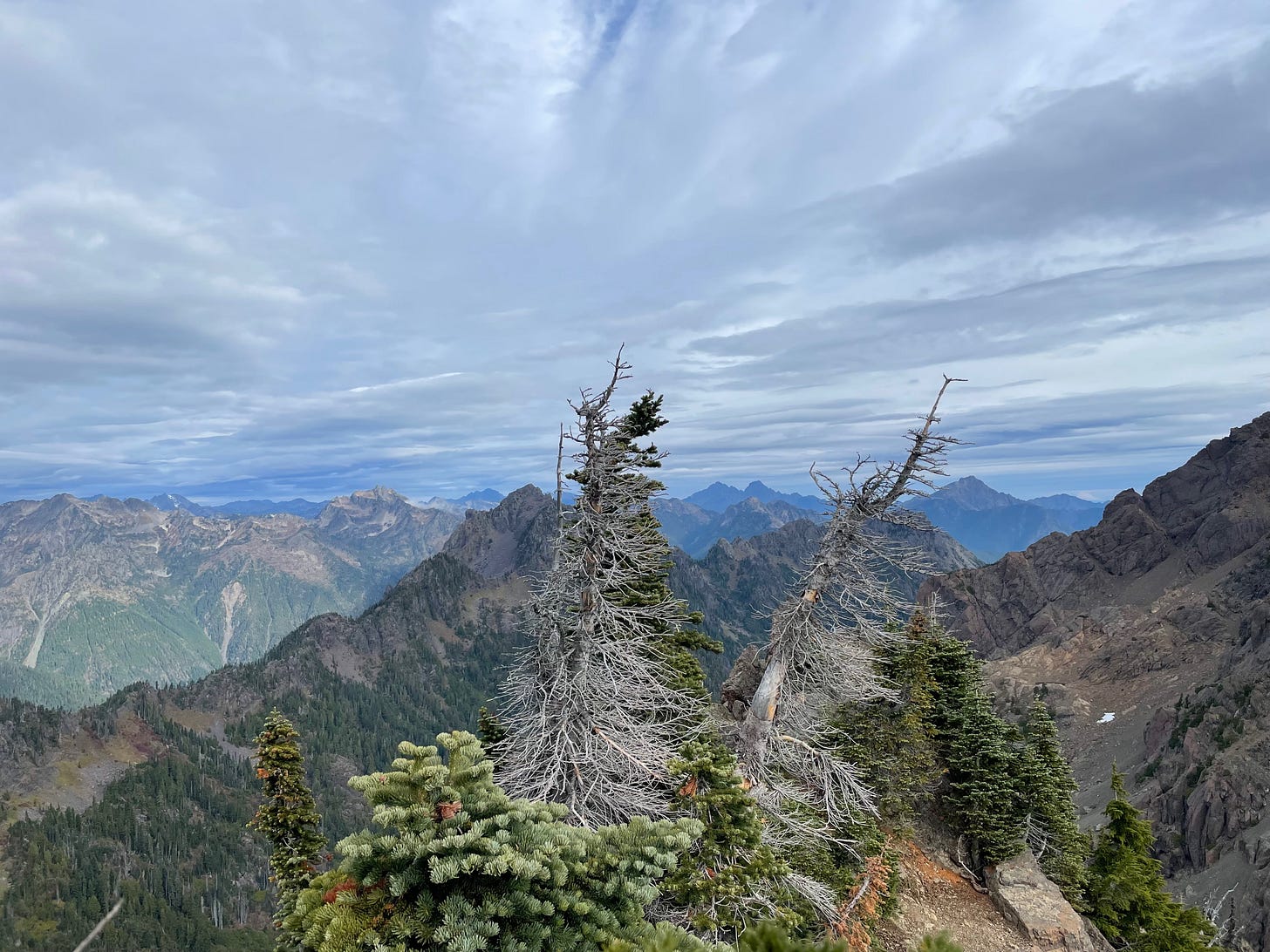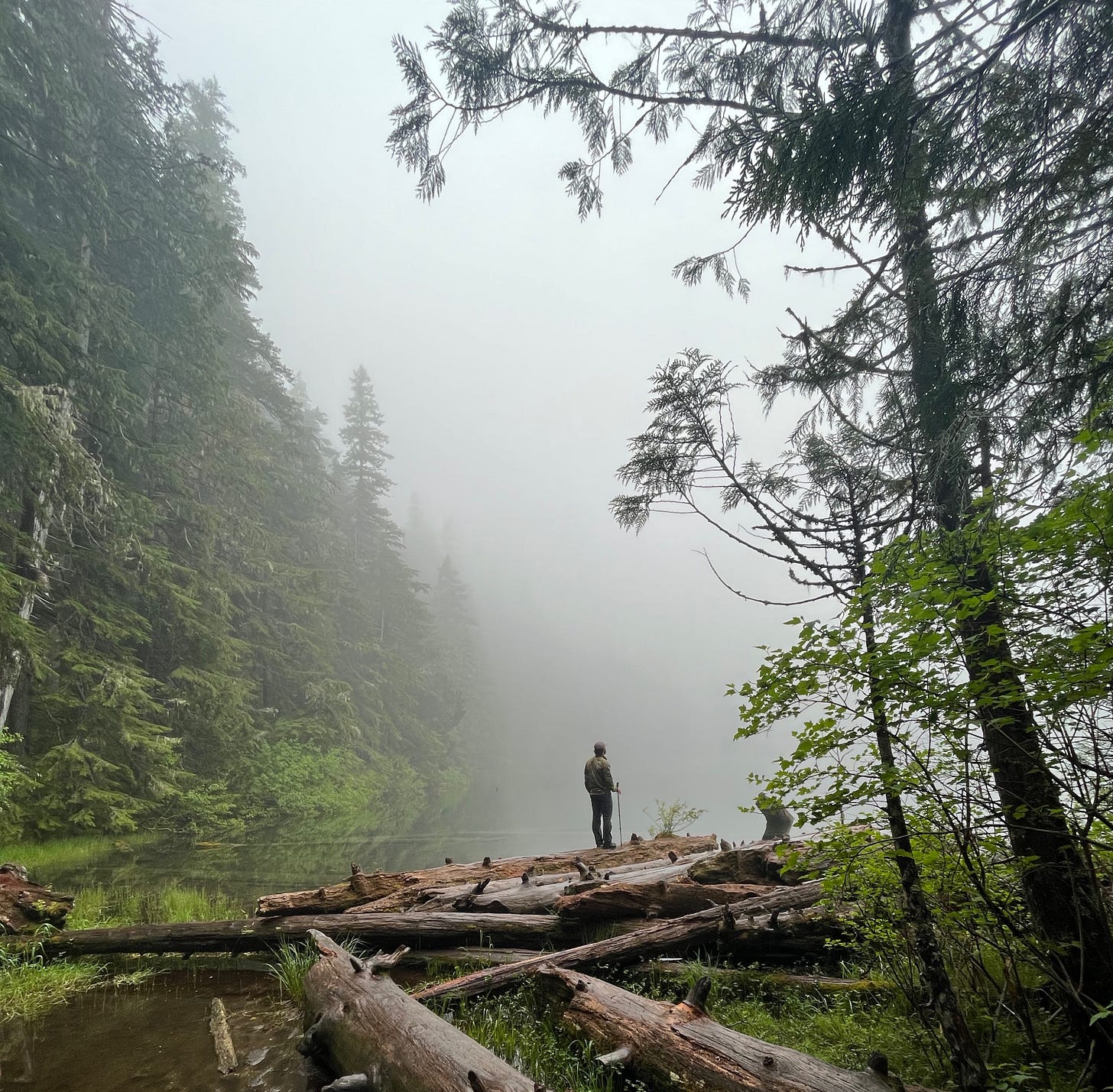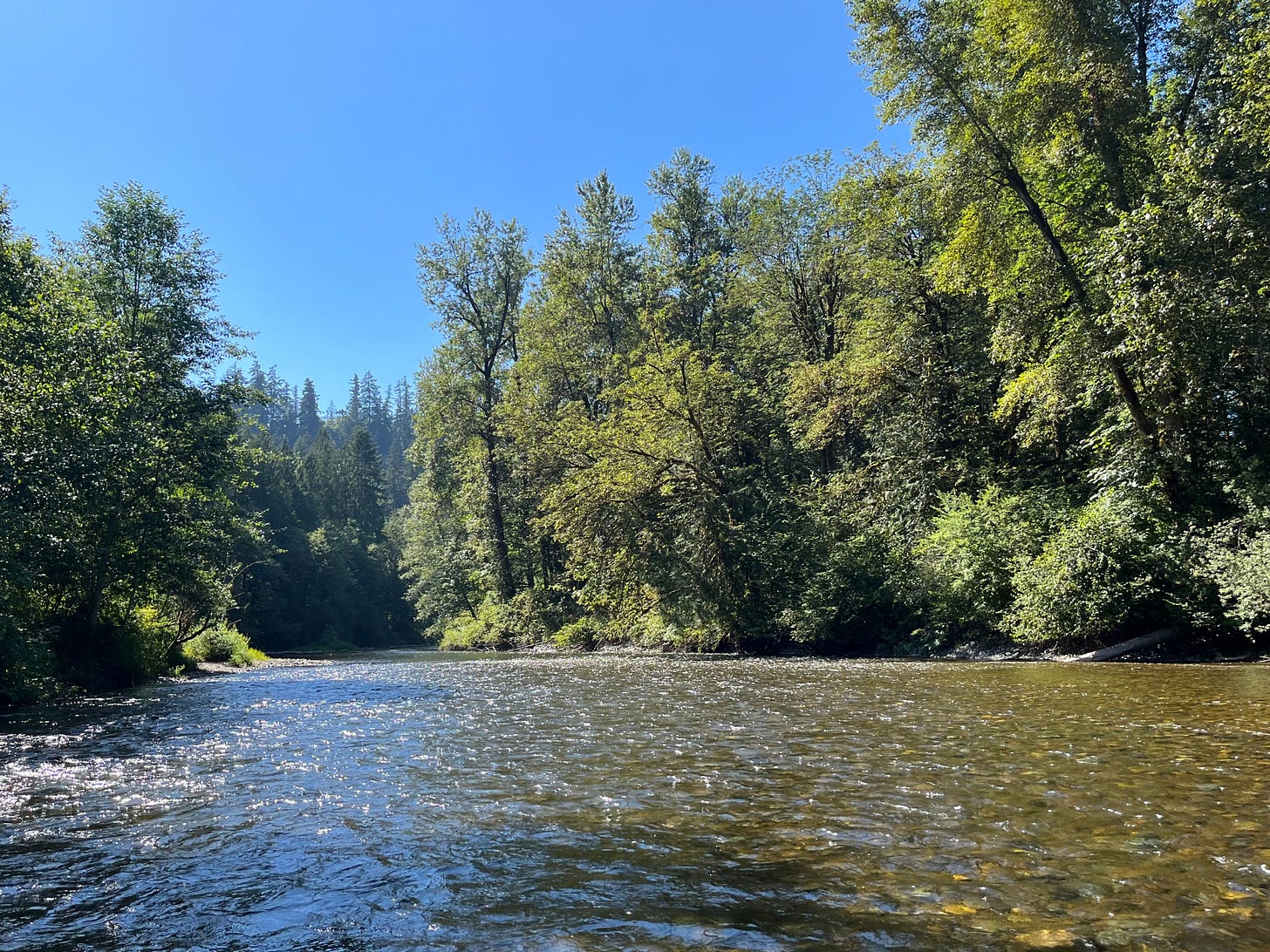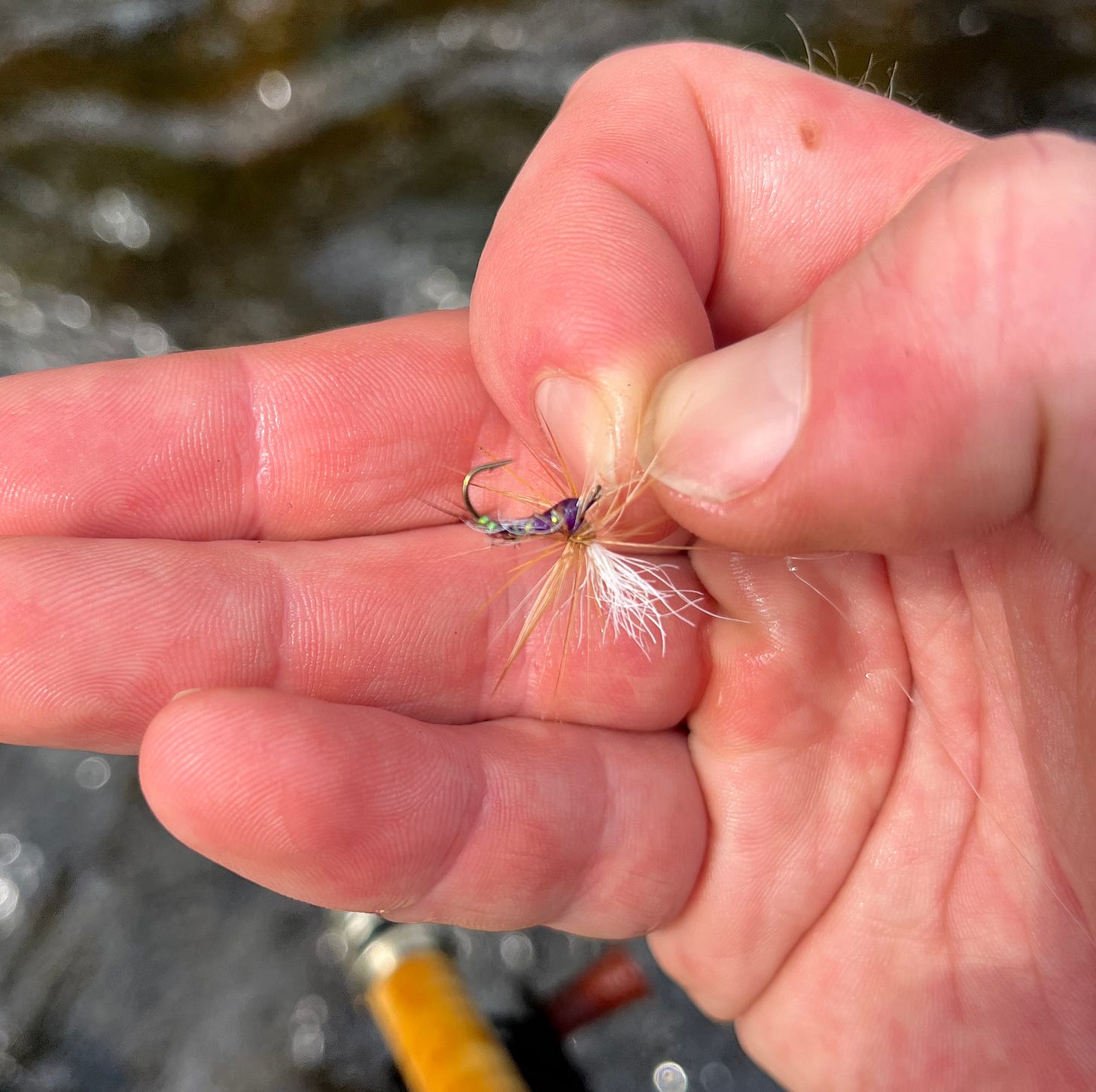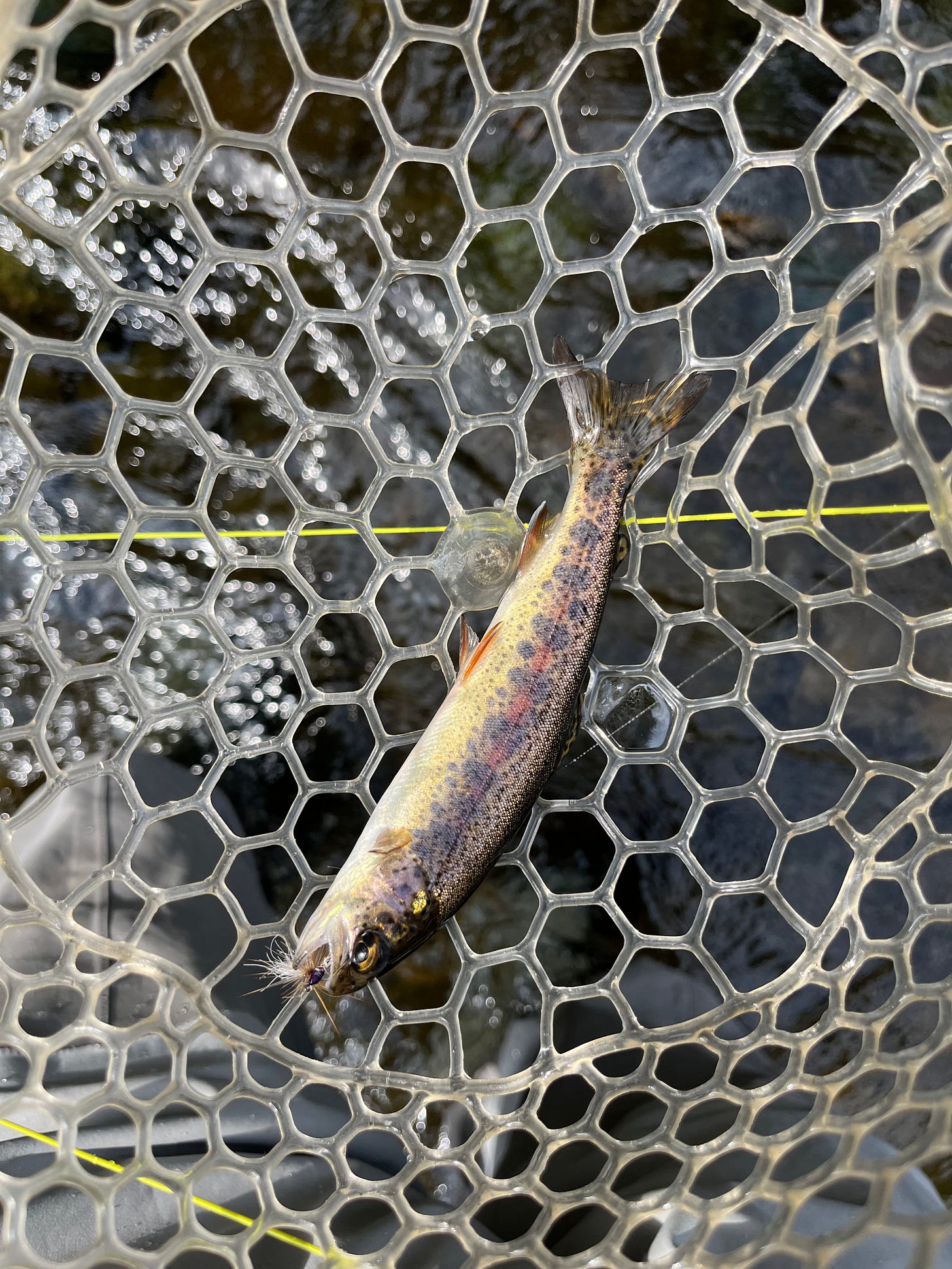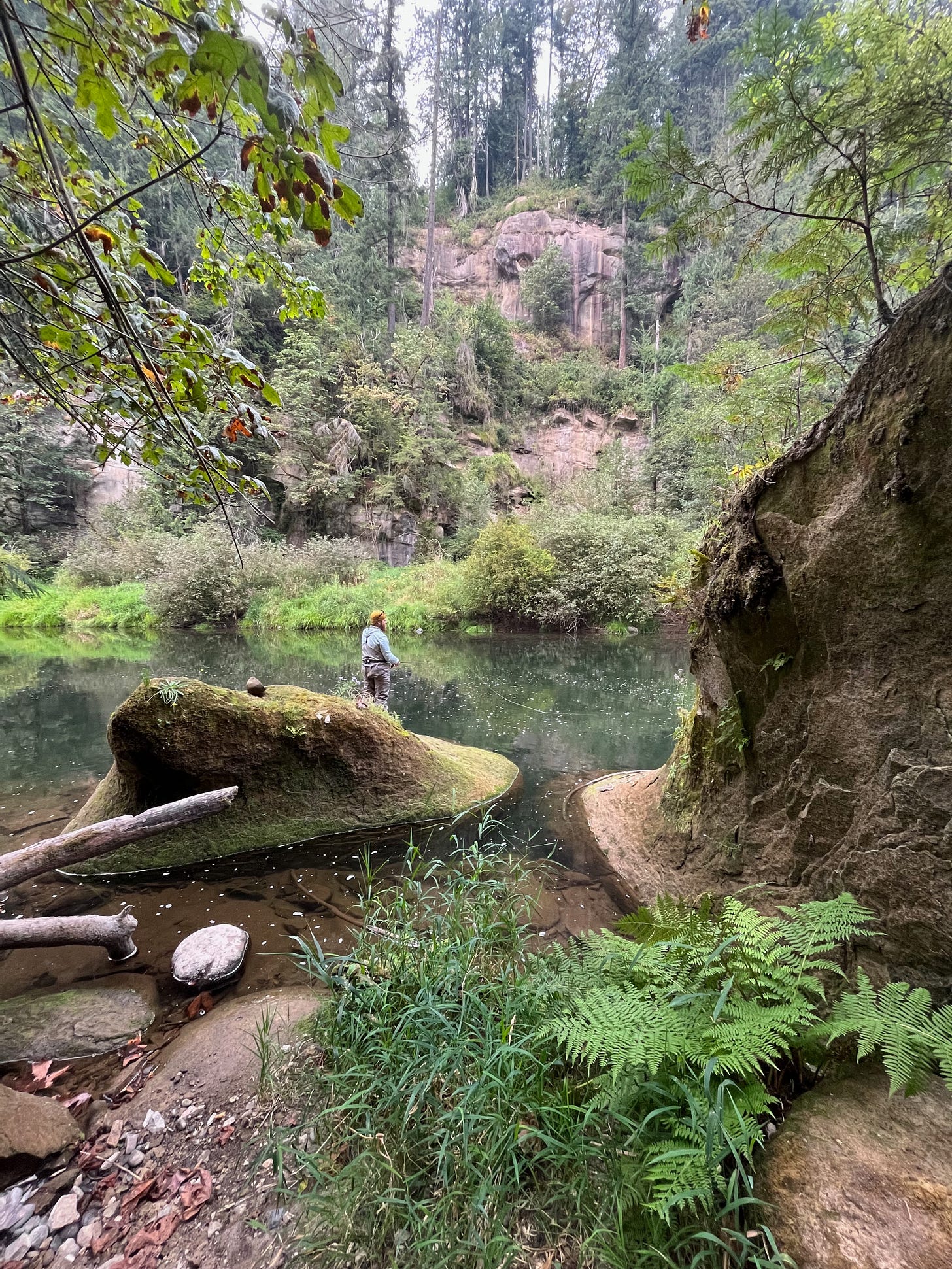Washington
Staring at my Garmin InReach and seeing there were still miles to be walked up an unreasonable grade, my expletive riddled lament cracked open perfect silence.
Enjoying myself but naturally complaining the whole time, legs pumped step over step towards the summit of Mt. Ellinor. I hemmed, I hawed, and once again I realized the Midwest had more the suggestion of hills rather than the reality of them. Foothills are beautiful, but the tax for legitimate panoramas is around a thousand feet of elevation gain per mile.
It was 36 degrees and slightly breezy, an ideal temperature for moving uphill with too much heavy stuff in a long sleeve merino tee. I had yet to find a decent trout stream, or a job for that matter, so pushing into the various mountain ranges surrounding Tacoma became a full-time occupation. Yes, my wife supported this.
Continuing up the slanted landscape, pine needles wove into a soft springy red carpet; drawing (or dragging) me towards the promised land of Olympic National Park. Rainforest turned into shale, shale turned into slabs of prehistoric stone. Eventually craggy vertical earth sawed into a vast sky, peaks shearing clouds as they slipped in and out of spires.
Finally reaching the summit, a cream sky met tectonic plates frozen in an eons long collision.
October meant lingering snowflakes and a sub freezing temperature this high up. Hearty fir looked ragged and calloused from battering winds. Landslide smattered draws filled in the gaps between alpine valleys buttressing shale and sandstone skyscrapers.
Stepping on to the summit proper and finally stationary, my pack slid onto an earthy nook while I settled in to catch a break from the wind. Gulping heavy breaths to ease aching limbs, my body asked what I had to offer for the recent effort. As was becoming ritual after a hard climb I commenced in making the mountain main course.
First was to get a rolling boil inside of my cooking equipment—a heavily used and poorly cleaned Jet Boil. I had left a fuel canister inside for entirely too long following sniper school, and a thin layer of rust had oxidized into the bottom. I told myself it was strengthening my immune system knowing full well that was highly unlikely.
Next, and arguably most critical, the Maruchan Ramen Noodles and accompanying “chicken” flavor packet. Beautiful, delicious, fat and sodium soaked ramen. This would be bathed in a hearty smear of Cholula poblano hot sauce. It’s not much, but the slop of calories and salt helped to ease sore feet and raw shoulders.
Surveying the peak again, I reflected on how my scenery had gone from a corn field for thirty years to this.
When we left Indiana, the cited reason for our move was my wife’s incredible opportunity to work in performance enhancement and my desire for a new setting. Less advertised and more personal, I realized something was trending (significantly) in the wrong direction and I needed a drastic change.
I could feel something off in my head. Not physically manifested but not without sensation. An inkling, almost a creeping. My days scouting rivers and wilderness and had been punctuated with the same deep blue periods from Indiana despite major lifestyle alterations. Not quite sadness and not quite anger; a numb sense of bitterness and melancholy drove me into the foothills of Mount Rainier and peaks of Olympic National Park.
When struggling up a steep grade and sweating heavily under a pack, I seemed to move just fast enough to leave that creeping shadow behind. Endorphins would mix with sweet sappy fern, fir and goats-beard like cough syrup staving off symptoms of the flu. But eventually the creeping dark periods would weep back into my subconscious.
While my daydream slipped back into reality I swirled the last tendrils of chunk chicken and poblano noodle soup around the bottom of my meal, softly tracking a snow storm brewing over peaks hours away. I looked down to see the entirely too beige dish had been reduced to scraps. Sloshing water over my stove and drying it briefly, I relished slipping back into boots and retrieving trekking poles for the descent at last.
Ankles snapping and shoulders popping while lifting heavy cargo, I slipped my limbs into damp shoulder straps and sharply tightened everything down. There was a haze from lingering sentiments weighing over my summit visit, and staring down the shale coated descent I made a promise to finally gain insight into my troubles.
Realizing that no mountain was tall enough and no bud sticky enough to make these dark inklings disappear—I left that mountain and make the first series of calls for mental health help. I found a professional who shared my values and background, and that I could feel comfortable with. The first series of these meetings ended with one sentence that would cloud my sense of self indefinitely.
“My initial impressions lead me to believe you have a Bipolar disorder, most likely Bipolar 2”
I had come to this final appointment with waders and pack ready to go, having a sense of how our recent sessions had been going. The therapy team made a diagnosis, the river allowed me to process things. I would leave that appointment and pick up my prescription wanting to think about a whole lot of anything that wasn’t associated with “being crazy”.
An hour later I was putting the truck into park near an abandoned trailhead. I’d been scoping this area out for a while and felt like an initial recon of the area would give me something positive to chew on while I soaked in this new information. Sitting in the driver’s seat and looking at the CVS bag, someone would have thought I was contemplating my first dose of fentanyl.
“You don’t need this, you’re just being a pussy,” the first set of second thoughts seeped into my head.
“Throw this in the river, you’re fine without meds.” I thought about emptying the pills onto the pavement and crushing them with my heel, a rebellion against perceived weakness.
“Guess you just quit trying all over again. This babyshit-soft mentality is why you never became a green beret.” That last one stung and almost got me to hurl the chemical help into the oblivion of a nearby rubbish bin.
“Suicide rates are 10-30 times greater in those with a diagnosed bipolar disorder,” I finally paused and thought better of rejecting my initial medical opinion. Ripping open the bag and grabbing a singular pill, I softly dropped it into my pocket while walking to the truck bed to prepare my gear for a day trip.
Tailgate slamming shut, doors locked, and pack loaded, I set off towards a trout stream found only by networking and months of Google Maps scouring. Bobbing along and finding a stride, I rolled the pill around my palm wondering what would happen next. Should the lore of my military companions manifest completely, and I lurch into a dramatic medical event in the river, my last words would likely be “leave me for the trout, may they get fat and be caught by my friends”.
A cupped hand met my mouth, and I swigged cool clear water as Lamictal moved into my bloodstream. The next chapter of my life began with steps towards clear water with muddy thoughts.
Accustomed to spending an unreasonable amount of my day under a rucksack and walking nowhere in particular, I pushed this new change out of my mind and fell into a slow and steady cadence.
This was a beautiful summer day, with the foliage radiating the scent of sweet sticky pine as it basked in the sun. Mixed gravel and soft soil wove through a gradient of greens, mossy conifers dominating the ridges surrounding me. My overloaded gear bag cut into atrophied shoulders, uncomfortable but reassuring after years of practice.
The Green River Gorge offered a sweeping view of the orange, brown and brilliantly hued shallow river. It was the same rocky bottom as Colorado, but with the mild depth and smaller stone of an Au Sable river.
In some areas, bubbling riffles hid juvenile trout. They seemed to flit and dart traversing the sandstone riddled bottom—moving from shadow to shadow to avoid larger predators. These shallow rapids posture and present. They roll, they sweep, it almost seems like strong enough riffles can practically boil. But one can see the slips and cracks to find a passible route. Even a tumble is only punished with filled waders.
But in some areas the river’s millennia of persistence had carved deep arterial gashes into sedimentary rock, creating bottomless flows of green water sheltering salmon and monster rainbows. These honey holes held unlimited opportunity and silent danger in ample supply.
As experienced anglers will know, deep water doesn’t necessarily “fight” a person misstepping into it’s domain. Rather, slipping into these swollen pockets rip anglers downriver with titan strength. Churning, sweeping, and all consuming, waders quickly fill to the brim and gear becomes saturated—what was once an asset becomes a lead weight clawing the helpless towards real danger. In extreme scenarios this can ultimately lead to death.
However, these depths also housed the most extraordinary opportunities. Fishing far below the surface could produce trout of Moby Dick proportions, generously rewarding persistence in dangerous territory. Understanding how to safely navigate these deep and dangerous parts of the river, like my own mind, allowed me to reap the rewards that lay waiting both in the context of fishing and mental illness.
Most days, I felt a sense of numb or deadpan that was at best monotonous and at worst annoying. Much like the bubbling and churning shallow water, my bark was worse than my bite. While a bit of a curmudgeon, I would still consider myself completely harmless. This would then be offset by a fury of activity. Some hobby, passion, or flippant interest would find a way to inject the dopamine I only found in drugs otherwise. Simply feeling happy was good, so feeling a sense of drive in mania was like a blissful oasis of who I had been before my father died.
But, inevitably, feast turned to famine. While depressed, “slipping in the shallows” meant not leaving the house for a few days and ignoring texts or calls from loved ones. When manic, “slipping in the shallows” meant a churning, sweeping, and all consuming swan dive into bottomless and violent waters. Not yet understanding anger is a mask for more vulnerable emotions—my acute self loathing turned into a swelling rage. Only due to the grace of my wife and a hand full of friends would I ultimately drift to shore heaving and feeling shame.
And really, having an abstract understanding that I may be different is what lead me to pursue isolated activities like fly fishing in the first place. Not knowing what would set me off, or how I would react to emotionally charged situations, the wilderness offered me a solitude saturated embrace. I could punish myself for transgressions in peace.
Endorphins became my dopamine. The metronome of a fly rod, the attention to detail with line weight, tippit construction, and fly selection allowed me to hyper focus productively during troubled times. Loneliness proved to be an ally; not something I was proud of but had always been preferable for now obvious reasons.
But I finally had a fresh start, and beginning from scratch is remarkably similar to scouting a new river. First steps usually involve a survey of the terrain and an analysis of its features. What can I use to my advantage, and where are potential hang-ups? What boot and wader selections can I make early on to better navigate the current? Do I have enough food? Do I have enough water? These rituals are important for all, but are critically important with a temperamental balance in my worst unmedicated moments.
But when those variables are controlled—the next steps feel like choreographed bliss. Having carefully planned and accounted for the majority of that which can be controlled, I could simply to set by the river and observe. These quiet moments prior to action allowed for ideas and strategies to flow freely. The concerto of crisp air laced with hints of sandy earth and moss harmonized alongside the vibration of cool water. Complete presence and calm following so much restlessness.
On this particular day, my eyes flittered to grassy banks overhanging slow water, noting that floating line and an imitation mouse would lure resting brown trout into a frenzy. The trick was to make the fish think the small mammal had mis-stepped into the river, and was frantically swimming towards the safety of an opposing bank.
However, fish generally only travel at night. Also working against me, the predators I sought had not been interested in thick and colorful streamers thus far. Han Solo may never want to know the odds, but given how my day had gone I elected to side with probability (smaller fish).
The sunken hues of the river bubbled into a large pack of golden stone riffles. Several frothy lines flanked by ringed ripples indicated that smaller fish were taking advantage of a mid-day lull in predator movement to feed.
These baby rainbows are like the “little big men” of the trout kingdom—unusually aggressive and extremely easy to catch because of this. They strike, they jump, and generally will full tilt swallow a fly of any size. And when you’re in the throes of a tough time mentally, there is no joy like catching a certified slew of young and dumb trout.
Seeing that the overhanging branches across the river were dangling over my bubble were buzzing with insects, and protected from larger pockets of water by jagged rock, all signs pointed to this area being positively trouty. I started marginally upriver and offset about 20 meters, patiently watching. Stay low, stay quiet, stay still. These trout have a sort of “spidy sense” and awareness of something in the environment being off. I crouched on a nearby rock to let my breathing and heart rate settle.
The natural order of things started to churn again after disruption. Birds perched on goats beard covered limbs cautiously chirping. The ripples of small fish feeding became more numerous. Small game moved around a grassy riverbank while crayfish began to scurry from cover to copper hued cover at my feet. Enough time had lapsed, and enough complacency had set in, for me to start making effective casts.
Stripping line from my rod, I was sure to make sufficient measurements to “dead drift” my fly past them. This painstakingly slow pulling of line is followed by a slight flip and twirl of the wrist to keep a dry fly from speeding up and “drag racing” on the surface. While it may seem like a silly thing to worry about, human hunters might experience similar hesitation if the deer they’re glassing starts to rip across the field like a cocaine bear.
A naturally drifting fly gives the small trout time to lock in, make a decision, and finally strike. This could be on the first cast, the third cast, or even a cast after changing flies. The whole trick is to understand you’re the visitor in their home, and it’s your responsibility to meet the trout’s needs. Feeling confident, I started with my own version of a tried and tested formula from the AuSable.
Purple haze, as I called it, was something trout are inexplicably drawn to during most sunny days of the year. (Very poorly) tied with a light purple string and “flashibou” wrapped around, UV compound holds together this attractor fly designed to shimmer and dance on the surface. There was a pronounced bit of “hackle” protruding out of the top, designed to help keep this fly above water in the swifter and more violent Western flows. I had only started tying this particular pattern recently, and caught several trophy sized tree branches prior to my current trip. But today, my rainbow clad companions couldn’t get enough of it.
Some days on the river are just different than others. The sky bled a purple, pink and orange ember while afternoon lazily shifted into evening. Bathing the sandstone bottomed river in a deep and brilliant gold flake—a late summer sun perfectly accenting the fly’s highlights. The water vibrated with a glistening sheen, making underwater views almost impossible, but this mystery perfectly built the anticipation of a strike.
Weighted line gently delivered tippet with a soft landing, my purple haze twitched just enough to be appealing without seeming suspicious, and I would gently feed line down stream until a furious explosion meant another rainbow had screamed to the surface for an evening snack.
There was the sensation I couldn’t miss. Cast after cast produced violent hits, my impulsively bought 3 weight (thanks mania) bowed and flexed the entire afternoon while trout after trout shot out from their pockets to feast on my bourbon inspired Frankenstein. I would have been a top contender for the “is that bait, or a fish?” award for that month, but I could not have given less of a shit in that moment.
After a long emotionally charged day, this was enough.
Having caught my fill, I popped onto a particularly appealing boulder in the stream and surveyed the sun handing the heavens over to evening for the evening. Relaxed, excited, and tired, racing thoughts reflected huge shifts in circumstances.
I would come to realize that Lamictal didn’t hurl me into a numb and lightless depression. Therapy hadn’t tried to convince me I was a delicate flower needing to walk on eggshells for the remainder of my life. I didn’t have a prolonged afternoon of self pity where I felt the world had neglected me—there was only the sensation that I had a playbook for something I had anxiously buried with alcohol, chain smoked marijuana and anger before.
And this is what tough talking machismo doesn’t understand. Professionally led therapy isn’t a weakness. If that was the case, Michael Phelps wouldn’t be hauling his brass balls and twenty eight Olympic medals into a psychologist’s office to discuss his depression. If it were weakness, Tom Slatterly—a Delta Force Command Sergeant Major and veteran of Operation Gothic Serpent (the event that inspired Black Hawk Down), would not admit he used therapy after nearly committing suicide.
What professional therapy offers is an impartial and unbiased opinion of someone professionally sanctioned to guide us through the things we’re ashamed of. The right person will help to audit habits and ideas as objectively as possible. This involves taking the time to find the right person, often involving a few initial “interviews” with therapists who might not be a good fit.
They unpack Pandora’s box with both accountability and grace, and the end goal of helping to decode complex and difficult memories. Sometimes you’re Will Hunting, finally being loved and told “It’s not your fault”. Others, you’re a petulant child explaining why “this totally isn’t on me” to someone who can cut through your bullshit with a laser.
Watching the the stream wistfully glide by and the smaller rainbows bed down before larger prey came to fest, the vanished sun offered a canvas of purple and blue eddies in consolation.
This impressionist sky punctuated by translucent and opaque smatterings of clouds indicted it was my last chance to head out before dark. Finally working to shore, I peeled off waders and began to repack the dry bag before heading back to civilization.
And despite the stress of the morning and melancholy musings, there was finally a path winding towards better. It was not, for once, characterized by someone offhandedly telling me to “harden the fuck up”. I could live in positive moments without only thinking about how they would end. I could navigate negative situations without dwelling on their discomfort or injustice. There was really just a sense of being without having to hide any shame or part of myself.
Taking one last look at the river, I heaved the waterproof bag over my shoulder and breathed in deeply. The river shifted and turned, wind pushing its way through the canopy of fir before swirling in the canyon. Sand felt cool and smooth under tired feet, and a delicious sense of calm settled onto my shoulders where a heavy yolk had been for years. The day might not sound perfect to most, but it was perfectly fine for me.
To the people who believed me (and more importantly believed in me), thank you. I don’t communicate it well or nearly enough but I love you all dearly.





